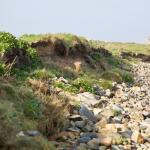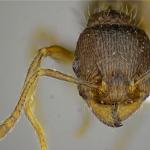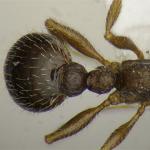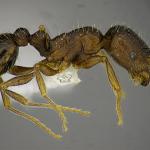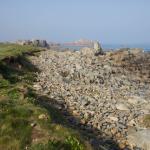T. impurum is a native species of western, central and southern Europe, similar in general appearance and habits to T. caespitum, except for being lighter in colour on average, and less thermophilic in its choice of nesting sites.
Until Wagner et al. (2017) showed how the two species could be reliably distinguished by precise morphometric parameters, T. impurum was tentatively separated from T. caespitum in the female castes on subjective qualitative characters, such as lighter colour and coarser dorsal sculpture of the petiole nodes. As both species exhibit some intraspecific variability in these characters, this was not entirely satisfactory, and samples had until Wagner et al. (2017) been assigned to the “T. caespitum complex”. Males of both species however, are reliably and fairly easily separated by qualitative differences in subgenital plate morphology, well illustrated in Wagner et al. (2017).
Seifert (2018) also gives a “striking” biochemical difference between the two species, which is that the pheromonal trail marker of impurum is a methylbenzoate derivative, whereas that of caespitum is a mixture of two methylpyrazine compounds.
References
Attewell, PJ and Wagner, HC (2019). Tetramorium impurum Förster (Hymenoptera: Formicidae), first record for Guernsey and the Channel Islands. Br. J. Ent. Nat. Hist., 32: 287-295.
Seifert, B., (2018). The Ants of Central and North Europe. Lutra Verlags und Vertriebsgesellschaft, Tauer, 408pp.
Wagner, HC, et al. (2017). Light at the end of the tunnel: Integrative taxonomy delimits cryptic species in the Tetramorium caespitum complex (Hymenoptera: Formicidae). Myrmecological News, 25: 95-129.
So far, only one verified record of T. impurum exists in the BWARS recording area, at Port Soif Common on the northwest coast of Guernsey, where a single nest was found in 2013 under a stone at the broken shoreline edge of old dune grassland, (Attewell & Wagner, 2019). Seifert (2018) stated that the specimens belonged to the eastern clade of the species, extending to the Benelux countries, central Europe, the Balkans and Asia Minor, whereas Attewell & Wagner (2019) showed that they quite definitely belong to the western clade of Iberia and western France. Close observation may detect the species elsewhere in the Channel Islands and potentially also in mainland Britain, especially the southwestern coastal areas.
The species has as yet no conservation status.
Wagner et al. (2017) includes dichotomous keys and discriminants for determination, albeit requiring very precise measurements.
The Guernsey site is a broken rocky shoreline where shallow stones sit on the edge of old dune grassland, with full sun exposure. It is therefore quite xerothermous. Seifert (2018) states that it is a less thermophilic species than T. caespitum, and, in central Europe at least, prefers loamier soils than caespitum.
Alates are found in the nests from late June to early November, flying from the end of July to the beginning of October, in the afternoon, on average seven weeks later than T. caespitum (Seifert, 2018).
2024


